
Downtown Columbus is the central business district of Columbus, Ohio. Downtown is centered on the intersection of Broad and High Streets, and encompasses all of the area inside the Inner Belt. Downtown is home to most of the tallest buildings in Columbus.

The East Broad Street Historic District in Columbus, Ohio is a historic district that was listed on the National Register of Historic Places in 1987. The district includes the section of East Broad Street from Ohio Avenue on the west to Monypenny Street on the east. It includes lavish residences, some converted to offices.

Saint Paul's Episcopal Church is a historic building in Columbus, Ohio.

The Columbus Foundation is a nonprofit charitable organization in Columbus, Ohio, founded in 1943.

Columbus City Hall is the city hall of Columbus, Ohio, in the city's downtown Civic Center. It contains the offices of the city's mayor, auditor, and treasurer, and the offices and chambers of Columbus City Council.
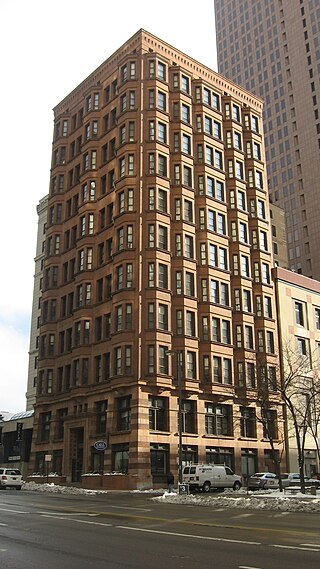
The Wyandotte Building is a historic building in Downtown Columbus, Ohio. It was considered the city's first skyscraper, built in 1897-1898 and designed by Daniel Burnham's architectural firm. It is listed on the National Register of Historic Places.
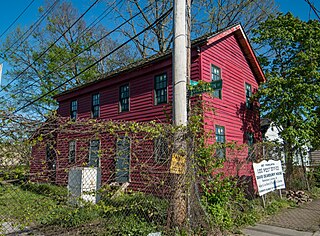
The Franklinton Post Office is a historic building in the Franklinton neighborhood of Columbus, Ohio. It was listed on the National Register of Historic Places in 1973. Also known as the David Deardurff House, it was built of hand-hewed logs by Deardurff in 1807. The two-story house sits on a limestone foundation. It is the oldest building in Columbus still on its original foundation. The building is on Gift Street, an area owned by Franklinton founder Lucas Sullivant, given to early settlers. The first post office in Franklinton was established here.

The Columbus Civic Center is a civic center, a collection of government buildings, museums, and open park space in Downtown Columbus, Ohio. The site is located along the Scioto Mile recreation area and historically was directly on the banks of the Scioto River.
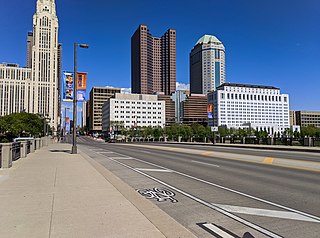
Broad Street is a major thoroughfare in Central Ohio, predominantly in Franklin County and Columbus. It stretches east from West Jefferson at Little Darby Creek to Pataskala. The street is considered one of Columbus's two main roads, along with High Street.

High Street is a major thoroughfare in Central Ohio, predominantly in Franklin County and Columbus. It stretches from the northern border of Columbus in Delaware County south to the southern boundary of Franklin County just past Columbus's municipal boundaries. The street is considered one of Columbus's two main roads, along with Broad Street.

The East Broad Street Commercial Building is a historic building in Columbus, Ohio. It was built in 1930 and listed as part of the E. Broad St. Multiple Resources Area on the National Register of Historic Places in 1986. The building has served numerous businesses, including doctor's offices, insurance agencies, and a Kroger store (1930-1946). Chinese restaurants operated out of the building from 1930 to 1995: Golden Lotus from 1930 to 1950 and Jong Mea from 1950 to 1995.

The Franklinton Apartments at Broad and Hawkes are a set of historic buildings in the Franklinton neighborhood of Columbus, Ohio. The buildings were built in 1900 and listed on the National Register of Historic Places in 2005. The rowhouse buildings are on West Broad Street, in the commercial center of the neighborhood. The two buildings are in an L-shaped plan and contain 22 apartments. The buildings are significant as they represent the neighborhood's residential investment following an industrial boom. They are one set of four L-shaped corner rowhouses built in Franklinton in 1900, and another was built in 1910. It is a defined property type relatively unique to the neighborhood, with only one other known example elsewhere in the city.

The Hanna House is a historic house in Columbus, Ohio, United States. The house was built in 1900 and was listed on the National Register of Historic Places in 1979. The building and its carriage house were built for James B. Hanna, president and co-founder of the Hanna Paint Company. The Hanna House was built at a time when East Broad Street was a tree-lined avenue featuring the most ornate houses in Columbus. The house remained in the Hanna family until 1975, and afterwards became an insurance office. The building is also part of the 21st & E. Broad Historic Group on the Columbus Register of Historic Properties, added to the register in 1988.

The C.E. Morris House is a historic house in Columbus, Ohio, United States. The house was built in 1897 and was listed on the National Register of Historic Places in 1986. The C.E. Morris House was built at a time when East Broad Street was a tree-lined avenue featuring the most ornate houses in Columbus; the house reflects the character of the area at the time. The building is also part of the 18th & E. Broad Historic District on the Columbus Register of Historic Properties, added to the register in 1988.

The Erwin W. Schueller House is a historic house in Columbus, Ohio, United States. The house was built in 1909 and was listed on the National Register of Historic Places in 1986. The Erwin W. Schueller House was built at a time when East Broad Street was a tree-lined avenue featuring the most ornate houses in Columbus; the house reflects the character of the area at the time. The building is also part of the 18th & E. Broad Historic District on the Columbus Register of Historic Properties, added to the register in 1988.

The Soloman Levy House is a historic house in Columbus, Ohio, United States. The house was built c. 1910-11 and was listed on the National Register of Historic Places in 1986. The Soloman Levy House was built at a time when East Broad Street was a tree-lined avenue featuring the most ornate houses in Columbus; the house reflects the character of the area at the time. The building is also part of the 18th & E. Broad Historic District on the Columbus Register of Historic Properties, added to the register in 1988.

The Heyne-Zimmerman House is a historic house in Columbus, Ohio, United States. The house was built c. 1912 and was listed on the National Register of Historic Places in 1987. The Heyne-Zimmerman House was built at a time when East Broad Street was a tree-lined avenue featuring the most ornate houses in Columbus; the house reflects the character of the area at the time. The building is also part of the 18th & E. Broad Historic District on the Columbus Register of Historic Properties, added to the register in 1988.
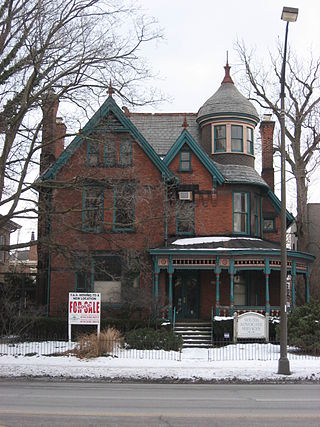
The Shedd-Dunn House is a historic house in Columbus, Ohio, United States. The house was built in 1888 and was listed on the National Register of Historic Places in 1986. The Shedd-Dunn House was built at a time when East Broad Street was a tree-lined avenue featuring the most ornate houses in Columbus; the house reflects the character of the area at the time. The building is also part of the 18th & E. Broad Historic District on the Columbus Register of Historic Properties, added to the register in 1988.
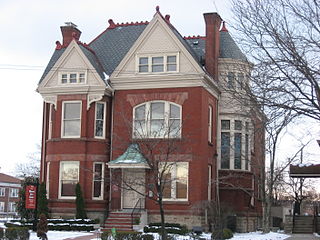
The Sharp-Page House is a historic house in Columbus, Ohio, United States. The house was built c. 1889 and was listed on the National Register of Historic Places in 1986. The Sharp-Page House was built at a time when East Broad Street was a tree-lined avenue featuring the most ornate houses in Columbus; the house reflects the character of the area at the time. The building is also part of the 18th & E. Broad Historic District on the Columbus Register of Historic Properties, added to the register in 1988.
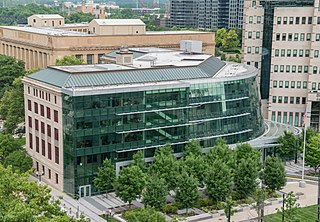
77 North Front Street is a municipal office building of Columbus, Ohio, in the city's downtown Civic Center. The building, originally built as the Central Police Station in 1930, operated in that function until 1991. After about two decades of vacancy, the structure was renovated for city agency use in 2011.





















